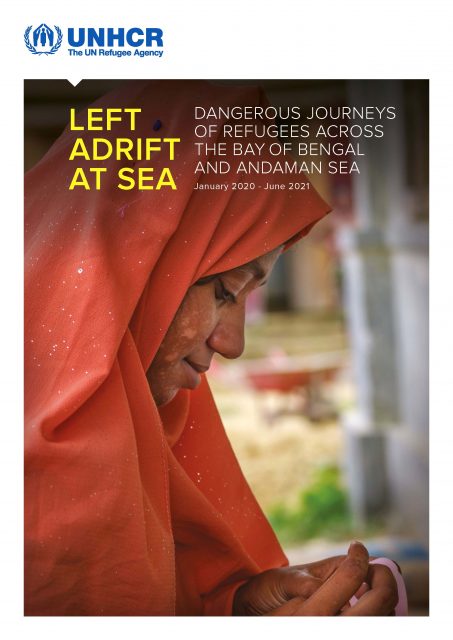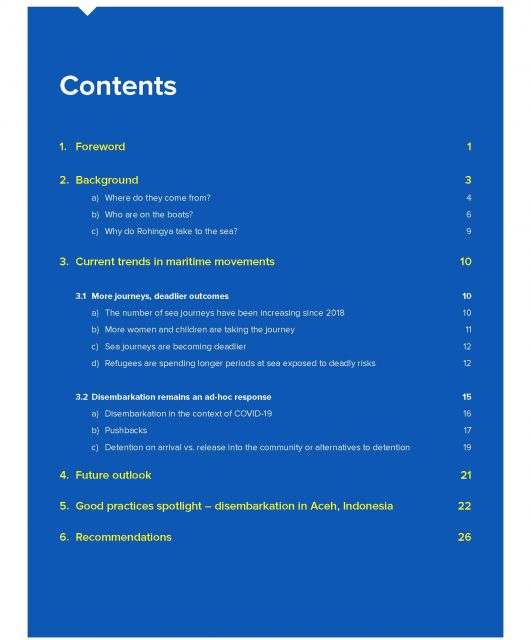Left Adrift at Sea: Dangerous Journeys of Refugees Across the Bay of Bengal and Andaman Sea January 2020 – June 2021



1. Foreword
2020 was the deadliest year on record for refugee journeys in the Bay of Bengal and Andaman Sea. Governments and leaders across Asia Pacific have been confronted with the question of whether we have collectively learned from history. Even more critically, we must ask ourselves whether we can sit by and repeat past tragic mistakes.
These past twelve months call to mind the events of 2015, another harrowing, landmark year for refugees and migrants at sea. The world was shocked by not one but two major, almost simultaneous humanitarian emergencies: the Andaman Sea crisis followed swiftly by the desperate journeys of more than a million men, women and children by sea to Europe.
Here in the Asia Pacific, the abandonment at sea of some 5,000 men, women and children by people- smugglers, with no government willing to bring them ashore, was a moment of reckoning. We watched in horror as human beings who had fled discrimination and persecution were left adrift, starving and sick, for months. Hundreds died. Not long afterwards, on the other side of the globe, the body of the young Syrian refugee, Alan Kurdi, washed ashore in Turkey. The collective tide of emotion was not only one of grief, but shame that such tragedies could happen.
In South East Asia, governments resolved to prevent collective inaction and its fatal consequences. Through the 2016 Bali Declaration, States acknowledged the need for a reliable and concerted response to this genuinely regional challenge. In establishing the ASEAN Trust Fund, member states also committed in 2015 to provide financial support to emergency and humanitarian relief efforts during similar movements of people, so that such vessels are never denied entry for fear of carrying the responsibility for reception and solutions alone.
Today, some six years later, these mechanisms have failed to live up to their promise. We see once again increasing movements of Rohingya refugees in the Bay of Bengal and Andaman Sea. We know their voyages are becoming more deadly. The longer a ship remains at sea, the more refugees are exposed to life-threatening risks. Increasingly, a majority of those aboard are women and children.
International Laws and conventions stipulate clear obligations for States to provide a safe harbour for those in distress at sea. But these legal frameworks derive from a much older and more instinctive truth – that rescue at sea is a fundamentally humanitarian act.
We have seen this humanity reflected in myriad acts of ordinary citizens around the world and in Asia. Acehnese fisherman who, with no fanfare or agenda, quietly rescued some 470 Rohingya refugees and brought them ashore between June 2020 and June 2021. Host communities in Bangladesh who, despite limited resources, have taken in more than 800,000 Rohingya refugees and provided them with sanctuary.
This report sets out the developing trends in movements of refugees in the Bay of Bengal and Andaman Sea, and the clear need for more comprehensive solutions. Equally critically, however, it gives voice to the thousands of refugees who have risked their lives in desperation – to reunite with family, to access education, to support themselves through gainful employment.
Among them, a young Rohingya father who was reunited with his wife and daughter after their seven- month ordeal at sea. “It was the happiest day of my life,” he told UNHCR staff upon seeing his family for the first time in over six years. “We are faceless, homeless and left adrift; we need a solution. I want to say to the whole world, please find a solution for us.”
Finally, this report makes clear and actionable recommendations on how to avoid further tragedies. These include bolstering search and rescue efforts at sea, stopping the deadly practice of pushbacks, and working towards a regional mechanism for predictable and equitable disembarkation.
For as long as States bordering the Andaman Sea and Bay of Bengal are reluctant to rescue and land those in distress at sea, that collective failure to act will have tragic and fatal consequences. We can and must do better.
Indrika Ratwatte Director of the Regional Bureau for Asia and the Pacific, United Nations High Commissioner for Refugees

